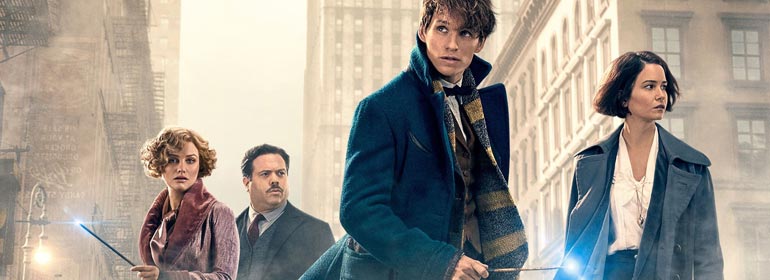It’s not difficult to scratch the surface and find a gay subtext in JK Rowling’s ‘Fantastic Beasts and Where To Find Them’, says Brian Finnegan.
A lot is being made of the gay allegory in JK Rowling’s prequel to the Harry Potter franchise, Fantastic Beasts and Where To Find Them, and as with those fantastic beasts, if you look just beneath the surface it’s hard to avoid. Set in New York in 1926, the film features an oppressed minority living double lives, appearing ‘normal’ on the surface but hiding their true nature for fear of persecution. They hang out in their own underground bars, and there’s a socio-political question at the heart of their existence: should they stay safely in the closet or should they come out as a united force and be who they are, in the face of religious fundamentalism and political oppression?
The same allegory has been identified in the X Men franchise, particularly X Men: The Last Stand, and the HBO vampire TV show True Blood, all of which feature oppressed groups of outsiders trying be themselves in oppositional societies, but the problem (for me) with all the gay between-the-lines stuff is that it’s generally overlaid with heterosexual romance. True Blood featured queer characters to give the subtext some weight, but with Fantastic Beasts, there’s only heterosexuality on show – in fact we get a double dose of it, and the only (possible) gay in the mix is the off-screen über baddie, Grindelwald, who was alluded to have had a romantic relationship with Dumbledore in the Harry Potter books.
Speaking of that über baddie, he’s part of a ‘if it ain’t broke don’t fix it’ element in Rowling’s screenplay, for what it presents are essentially grown up stand-ins for Harry, Hermoine and Ron, all on course for a big battle, somewhere down the line, with a super-villain who is only referred to in hushed tones by the characters that populate a multi-layered magical world that’s right in front of your eyes, yet hidden from view. In 1920s America muggles are called no-majs, and one of them becomes the stand-in for Ron, Harry’s hapless-with-a-heart-of-gold best friend.
Harry’s stand-in is Newt Scamander (Eddie Redmayne), an ex Hogwarts student who turns up in New York with a case full of magical creatures (which are banned in America) and immediately bumps into bumbling no-maj Jacob Kowalski, and conscientious witch, Porpentina Goldstein. Some of the magical creatures escape and aided and abetted by Jacob and Porpertina, Newt goes on a quest to retrieve them. Meanwhile another plot rises, in which an evil wizard (Colin Farrell) seeks to control the world, via a little girl who might (or might not) be the key to unleashing overpowering dark forces. Added to this mix is Porpertina’s sister, Queenie, a flirtatious witch with an eye for no-majs, in particular Jacob.
I may sound a little cynical about the set-up, but its execution is pretty spectacular, particularly in relation to the havoc those fantastic beasts wreak. Inside Newt’s suitcase there’s a whole menagerie of weird, wild and wonderful creatures, rendered in beautifully detailed CGI, while outside it, the battle between good and evil that slowly emerges reaches a hugely entertaining crescendo.
Director David Yates includes all sorts of cinematic allusions in the mix, including references to Citizen Kane and Brian De Palma’s Carrie, and of course the Harry Potter films, four of which he helmed. Eddie Redmayne is his old reliable self, not really stretching beyond the usual wide-eyed performance, while Katherine Waterston is given little to do other than look shocked and/or overly serious. Alison Sudol brings gentle humour to the proceedings with a flirtatious Queenie who has more than a shade of Marilyn Monroe about her, while Samantha Morton is her usual riveting self as witch-hating evangelist Mary Lou. Unfortunately Colin Farrell can’t stretch to embodying pure evil, so the bad guy fails to make an impact, thereby letting the core conflict of the film down. A brief appearance from Johnny Depp as Grindelwald, however, points towards much more exciting clashes to come.
There’s been lots of speculation online about whether Rowling will include a backstory that includes Grindelwald’s supposed homosexuality in the screenplay for Fantastic Beasts 2 (there are five in production). If it’s true that this first outing has a deliberately gay subtext, it would be nice if at least one actually gay character saw the limelight.
‘Fantastic Beasts and Where To Find Them’ opens nationwide on Friday, November 18
© 2016 GCN (Gay Community News). All rights reserved.

comments. Please sign in to comment.